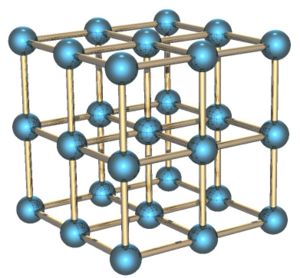Polonium: Difference between revisions
imported>Ro Thorpe |
imported>Ro Thorpe |
||
| Line 41: | Line 41: | ||
The beta form of polonium is hexagonal; it has been reported along with the alpha form several times in chemical literature. | The beta form of polonium is hexagonal; it has been reported along with the alpha form several times in chemical literature. | ||
Two papers report X-ray [[diffraction]] experiments on Po metal. | Two papers report X-ray [[diffraction]] experiments on Po metal.<ref>R.J. Desando and R.C Lange, ''Journal of Inorganic and Nuclear Chemistry'', 1966, '''28''', 1837-1846.</ref><ref>W.H Beamer and C.R. Maxwell, ''Journal of Chemical Physics'', 1946, '''14''', 569-569<ref> | ||
The first report of the crystal structure of Po was done using [[electron diffraction]].<ref>M.A. Rollier, S.B. Hendricks and L.R. Maxwell, ''Journal of Chemical Physics'', 1936, '''4''', 648-652. | |||
The first report of the crystal | |||
M.A. Rollier, S.B. Hendricks and L.R. Maxwell, ''Journal of Chemical Physics'', 1936, '''4''', 648-652. | |||
== Applications == | == Applications == | ||
Revision as of 21:11, 15 January 2011
| |||||||||||||||||||||||||||||||||||||||||||||||||||||||||||||||||||||||||||||||||||||||||||||||||||||||||||||||||||||||||||||||||||||||||||||||||||||||||||||||||||||||||||||||||||||||||||||||||||||||||||||||
Polonium is a chemical element in the periodic table that has the symbol Po and atomic number 84. A rare radioactive metalloid, polonium is chemically similar to tellurium and bismuth and occurs in uranium ores. Polonium had been studied for possible use in heating spacecraft.
Notable characteristics
Polonium has no stable isotopes and has over 50 potential isotopes. It is extremely toxic and highly radioactive. Polonium has been found in tobacco smoke from tobacco leaves grown at some specific places, as a contaminant [1][2] and in uranium ores. All elements from polonium onward are radioactive. The great radioactivity of polonium and its immediate neighbors to the right on the periodic table, and its stark contrast with lead and bismuth, is due to the great instability of nuclei containing 84 or more protons. Nuclei that contain 128 neutrons along with 84 or more protons are especially unstable. Curiously, thorium-232 and uranium-238 are in an "island of stability" which renders them stable enough to be found in large quantities in nature, but heavier nuclei are more and more affected by spontaneous fission. Even in milligram or microgram amounts, handling 210Po is difficult and requires special equipment because of the ability of Po to enter the vapour state. Internal exposure can expose tissues from alpha particles. This radioactive element dissolves readily in dilute acids, but is only slightly soluble in alkalis. It is closely related chemically to bismuth and tellurium. Polonium (in common with 238Pu) has the ability to become airborne with ease. More than one hypothesis exists for how polonium does this; one suggestion that that small clusters of polonium atoms are spalled off by the alpha decay.
The maximum allowable body burden for ingested polonium is only 1100 becquerels (0.03 microcurie), which is equivalent to a particle weighing only 6.8 × 10−12 gram. Weight for weight polonium is approximately 2.5 × 1011 times as toxic as hydrocyanic acid. The maximum permissible concentration for airborne soluble polonium compounds is about 7,500 Bq/m³ (2 × 10−11 µCi/cm³).
N. Momoshima, L.X. Song, S. Osaki and Y. Maeda, Environ Sci Technol. 2001, 35, 2956-2960 [3] report that microbes can methylate polonium. They also claim that methylcobalamin can also methylate polonium.
Solid state form
The alpha form of the Po solid is cubic (Po-Po distance is 3.352 Å), it is a simple cubic solid which is not interpenetrated. A myth has grown up from a single sentence in one of the original papers on the crystal structure as determined by X-ray powder diffraction that describes Polonium's structure as an interpenetrated cubic solid. While this is not the structure, a reasonable number of real examples of such an interlocking network have been found.
The beta form of polonium is hexagonal; it has been reported along with the alpha form several times in chemical literature.
Two papers report X-ray diffraction experiments on Po metal.[1]Cite error: Closing </ref> missing for <ref> tag[2]
Synthesis by (n,) reaction
In 1934 an experiment showed that when natural 209Bi is bombarded with neutrons, 210Bi is created, which then decays to 210Po via β decay. Polonium may now be made in milligram amounts in this procedure which uses high neutron fluxes found in nuclear reactors. Only about 100 grams are produced each year, making polonium exceedingly rare.[3]
Synthesis by (p,n) and (p,2n) reactions
It has been found that the longer lived isotopes of polonium can be formed by proton bombardment of bismuth using a cyclotron. Other more neutron rich isotopes can be formed by the irradiation of platinum with carbon nuclei.[4]
Testing humans
The case of the poisoning of the former Soviet operative Alexander Litvinenko has resulted in the need for a large number of humans to be tested for contamination with polonium. The method which is publicly explained by the British health protection agency [4] to to take 1000 ml of urine in a 2L beaker, add a known activity of either 208Po or 209Po (circa 0.2 Bq) before the addition of nitric acid. The urine sample is then evapourated to dryness, before dissolution in 6 M hydrochloric acid (after treatment with concentrated hydrochloric acid), the mixture is then treated with hydroxylamine HCl salt before adjustment of the pH. The polonium is then plated out onto silver discs before counting with an alpha spectrometer for at least 12 hours. The health protection agency claim that this method can detect and measure 210Po activitys as low as 0.02 Bq.[5]
References
External links
- ↑ R.J. Desando and R.C Lange, Journal of Inorganic and Nuclear Chemistry, 1966, 28, 1837-1846.
- ↑ Alpha Radioactivity (210 Polonium) and Tobacco Smoke
- ↑ http://www.rsc.org/chemistryworld/News/2006/November/27110601.asp RSC Chemistry World Q&A
- ↑ Atterling, H., Forsling, W. (1959). "Light Polonium Isotopes from Carbon Ion Bombardments of Platinum". Arkiv for Fysik 15 (1): 81-88.

